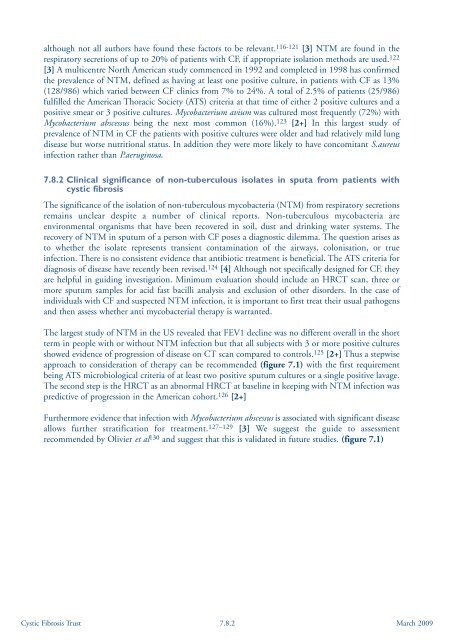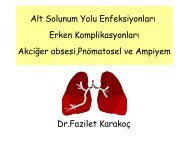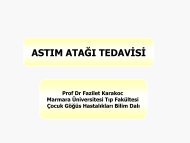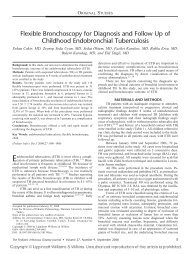Report of the UK Cystic Fibrosis Trust Antibiotic Working Group
Report of the UK Cystic Fibrosis Trust Antibiotic Working Group
Report of the UK Cystic Fibrosis Trust Antibiotic Working Group
Create successful ePaper yourself
Turn your PDF publications into a flip-book with our unique Google optimized e-Paper software.
although not all authors have found <strong>the</strong>se factors to be relevant. 116-121 [3] NTM are found in <strong>the</strong>respiratory secretions <strong>of</strong> up to 20% <strong>of</strong> patients with CF, if appropriate isolation methods are used. 122[3] A multicentre North American study commenced in 1992 and completed in 1998 has confirmed<strong>the</strong> prevalence <strong>of</strong> NTM, defined as having at least one positive culture, in patients with CF as 13%(128/986) which varied between CF clinics from 7% to 24%. A total <strong>of</strong> 2.5% <strong>of</strong> patients (25/986)fulfilled <strong>the</strong> American Thoracic Society (ATS) criteria at that time <strong>of</strong> ei<strong>the</strong>r 2 positive cultures and apositive smear or 3 positive cultures. Mycobacterium avium was cultured most frequently (72%) withMycobacterium abscessus being <strong>the</strong> next most common (16%). 123 [2+] In this largest study <strong>of</strong>prevalence <strong>of</strong> NTM in CF <strong>the</strong> patients with positive cultures were older and had relatively mild lungdisease but worse nutritional status. In addition <strong>the</strong>y were more likely to have concomitant S.aureusinfection ra<strong>the</strong>r than P.aeruginosa.7.8.2 Clinical significance <strong>of</strong> non-tuberculous isolates in sputa from patients withcystic fibrosisThe significance <strong>of</strong> <strong>the</strong> isolation <strong>of</strong> non-tuberculous mycobacteria (NTM) from respiratory secretionsremains unclear despite a number <strong>of</strong> clinical reports. Non-tuberculous mycobacteria areenvironmental organisms that have been recovered in soil, dust and drinking water systems. Therecovery <strong>of</strong> NTM in sputum <strong>of</strong> a person with CF poses a diagnostic dilemma. The question arises asto whe<strong>the</strong>r <strong>the</strong> isolate represents transient contamination <strong>of</strong> <strong>the</strong> airways, colonisation, or trueinfection. There is no consistent evidence that antibiotic treatment is beneficial. The ATS criteria fordiagnosis <strong>of</strong> disease have recently been revised. 124 [4] Although not specifically designed for CF, <strong>the</strong>yare helpful in guiding investigation. Minimum evaluation should include an HRCT scan, three ormore sputum samples for acid fast bacilli analysis and exclusion <strong>of</strong> o<strong>the</strong>r disorders. In <strong>the</strong> case <strong>of</strong>individuals with CF and suspected NTM infection, it is important to first treat <strong>the</strong>ir usual pathogensand <strong>the</strong>n assess whe<strong>the</strong>r anti mycobacterial <strong>the</strong>rapy is warranted.The largest study <strong>of</strong> NTM in <strong>the</strong> US revealed that FEV1 decline was no different overall in <strong>the</strong> shortterm in people with or without NTM infection but that all subjects with 3 or more positive culturesshowed evidence <strong>of</strong> progression <strong>of</strong> disease on CT scan compared to controls. 125 [2+] Thus a stepwiseapproach to consideration <strong>of</strong> <strong>the</strong>rapy can be recommended (figure 7.1) with <strong>the</strong> first requirementbeing ATS microbiological criteria <strong>of</strong> at least two positive sputum cultures or a single positive lavage.The second step is <strong>the</strong> HRCT as an abnormal HRCT at baseline in keeping with NTM infection waspredictive <strong>of</strong> progression in <strong>the</strong> American cohort. 126 [2+]Fur<strong>the</strong>rmore evidence that infection with Mycobacterium abscessus is associated with significant diseaseallows fur<strong>the</strong>r stratification for treatment. 127–129 [3] We suggest <strong>the</strong> guide to assessmentrecommended by Olivier et al 130 and suggest that this is validated in future studies. (figure 7.1)<strong>Cystic</strong> <strong>Fibrosis</strong> <strong>Trust</strong> 7.8.2March 2009






